Abstract
This paper focuses on passive symmetry effects in Germanic. We describe two large-sample judgment experiments with native speakers of Norwegian and Swedish, two partially symmetric passive languages. The results fail to support predictions of Anagnostopoulou’s (2003) seminal locality approach to passive symmetry in these languages. We propose that constraints on object ordering in these varieties are better modeled on a revised version of classic case-based theories. On this approach, patterns of object ordering are governed by variation in the way that case is assigned to objects. In addition, the Norwegian results suggest a shape conservation effect in object shift contexts not previously reported in the literature. Theme-recipient orders in Norwegian object shift contexts are available for just those speakers who also accept theme-recipient orders in active non-object shift contexts. This object ordering constraint applies in the same environment that another, much better described ordering constraint applies, namely Holmberg’s Generalization effects. We show that these results are explained by Fox and Pesetsky’s (2005) cyclic linearization algorithm together with the assumption that theme-recipient orders vP-internally reflect short theme-movement above the recipient.
Similar content being viewed by others
1 Introduction
A central challenge for formal theories of argument movement is to model cross-linguistic variation in patterns of passivization out of double object constructions, a set of issues sometimes referred to as the “passive symmetry” problem. Work in comparative syntax dating from the late 1980s has revealed that languages with passive movement fall into one of two main classes with respect to passivization out of double object constructions. One class of languages—symmetric passive languages, including Norwegian, Kinyarwanda, Kinande, and some dialects of British English—has the property that, out of a double object construction, either object may passivize (Baker 1988; Doggett 2004; Georgala 2011a; McGinnis 1998, 2001; Ura 1996; Woolford 1993). We illustrate this in the Norwegian example in (1).
-
(1)

By contrast, “asymmetric passive languages” including Fula, Swahili, Chichewa, Danish, and many varieties of English, allow recipient arguments but not themes to passivize out of double object constructions (Baker 1988; Bresnan and Moshi 1990; Postal 2004; Woolford 1993). We illustrate this in the Danish example in (2).
-
(2)

The challenge for formal theories posed by these facts is to explain the nature of the representational differences between double object passives in these two classes of languages. In the generative literature, two main approaches to these facts have been proposed. One approach prominent in the Government and Binding tradition explains this variation in terms of differences in the way that nouns are licensed via case in these two kinds of languages. A premise of this approach is that, in passive contexts, the objective case that would otherwise be assigned by the transitive verb is “absorbed” by passive morphology, and derived subjects move to subject position to receive case (Jaeggli 1986; Roberts 1987). On this approach, the symmetric pattern reflects the fact that case for either object may be absorbed, with the consequence that either object may passivize. In asymmetric passive languages, on the other hand, only the case that would otherwise be assigned to the recipient may be absorbed, with the consequence that only the recipient argument may passivize.
A second approach—the consensus in recent minimalist work—has explained these facts not in terms of case but rather locality. On this approach, what blocks theme passivization in asymmetric passive languages is the fact that the recipient argument intervenes between the thematic position of the theme and subject position. The relevant case- or category-sensitive dependency relation responsible for theme passivization cannot be established because of matching case or categorial features on the intervening recipient argument. What fixes this problem in symmetric passive languages is the availability of a short theme movement to an “equidistant” position—typically an outer specifier of the same projection hosting the recipient. A subsequent movement step raises the theme to subject position. Because this intermediate “stepping stone” position is in a projection with a segment immediately dominating the recipient argument, neither of these movement steps “crosses over” the recipient argument, and therefore no locality problem arises (Anagnostopoulou 2003; Doggett 2004; McGinnis 1998, 2001; Jeong 2007; Ura 1996). We illustrate this approach in (3).
-
(3)
[TP Theme [XP
ThemeRecipient [YPTheme] ] ]
A crucial empirical point on which the locality analysis turns is the availability of independent evidence of the short theme movement in (3). Anagnostopoulou (2003) proposes that evidence to this effect comes from patterns of object ordering in passive and active object shift sentences in Mainland Scandinavian. In particular, Anagnostopoulou (2003, 2005) and Bobaljik (2002, 2005) note that, for varieties of Mainland Scandinavian that allow theme-recipient (Th-R) orders in passive contexts—Swedish and Norwegian—some speakers also allow Th-R orders under object shift. In Danish, which does not have theme passives, Th-R object shift constructions are also bad. We will present a more nuanced characterization of this cross-speaker and cross-linguistic variation in the following discussion, but for the moment let us summarize the relevant facts as in Table 1. Anagnostopoulou (2003, 2005) takes the facts in Table 1 to support the escape hatch movement illustrated in (3). In particular, Anagnostopoulou proposes that the same short theme movement that feeds Th-R orders in object shift also feeds theme-passivization.
The locality approach makes a strong prediction about cross-speaker variation in Norwegian and Swedish, namely that the same speakers that accept Th-R orders in active contexts will also accept Th-R orders in passives. This paper reports on a large-sample controlled judgment experiment with speakers of Norwegian (N = 500) that fails to support this strong prediction of the locality approach. We propose that constraints on object ordering in these varieties are better modeled on a revised version of the case-based approach proposed by Holmberg et al. (in press). On this approach, patterns of object ordering are governed by variation in the way that phi-probes agree with theme and recipient arguments.
The situation in Scandinavian is complicated by the fact that Swedish is not an unqualified symmetrical language on a par with Norwegian. As noted by Holmberg and Platzack (1995), theme passives with verbs like ‘give’ and ‘send’ are degraded. Lundquist (2014) shows that recipient passives, too, are degraded with the verb ge ‘give’. However, as noted in these works, both recipient and theme passives improve when the ditransitive verb is bimorphemic, composed of a prefix plus a stem in the manner of till-dela ‘award’, före-visa ‘show’, er-bjuda ‘offer’. These claims are largely supported by a second experiment which we report on here. We will argue that the prefixes of the bimorphemic verbs provide an extra case-marking feature needed in Swedish.
The discussion is organized as follows. Section 2 describes the Norwegian judgment experiment and presents an analysis of the Norwegian results drawing on Haddican and Holmberg’s (2012) analysis of similar facts in British English dialects and Fox and Pesetsky’s (2005) cyclic linearization algorithm. Section 3 analyzes and discusses results from the Swedish experiment.
2 Object ordering in Norwegian
2.1 Experiment 1
We begin by describing an experiment designed to test predictions of Anagnostopoulou’s seminal proposal about symmetric passives in Mainland Scandinavian. We will focus specifically on the Norwegian forms as in (1), repeated here.
-
(4)

The base order for objects in Norwegian active double object constructions with full DP objects is R-Th, as shown in (5).
-
(5)

Norwegian DOCs share with their English counterparts the restriction that inanimate DPs cannot be recipients (Anagnostopoulou 2003; Green 1974; Harley 2002):
-
(6)

The same restriction applies in both R-Th and Th-R orders in passives, dispelling the possibility that the theme passive is derived from a covert prepositional dative.
-
(7)

Anagnostopoulou’s (2003, 2005) proposal for Mainland Scandinavian focuses on the relationship between ditransitive passive sentences and object shift sentences with two objects, as in (8) from Norwegian.
-
(8)
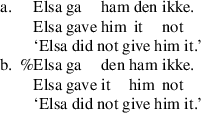
“Object shift” in the Scandinavian context refers to constructions where one or both objects raise out of the verb phrase, as diagnosed by their surface position to the left of low adverbials including the negative morpheme ikke. Shifting is generally restricted to weak, unstressed pronouns. In Scandinavian languages, object shift is only possible when the main verb also evacuates the VP. In perfect contexts, for example, where the participle does not raise out of VP, object shift is blocked, as shown in (9). The sensitivity of object shift to verb movement is known as “Holmberg’s generalization” (Holmberg 1986, 1999).
-
(9)
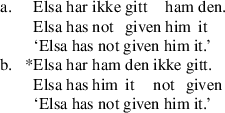
Anagnostopoulou (2003, 2005) proposed that Th-R object shift sentences like (8b) and theme passives share an abstract source, namely a derivational step moving the theme to an outer specifier of the head introducing R, which is ApplP in Anagnostopoulou’s proposal. We illustrate this in (10). In passive contexts, the higher of the two arguments will be attracted to subject position. In object shift contexts, both objects will raise into the middle field. An order preservation requirement will ensure that the lower argument “tucks in,” so that the two objects are ordered Th-R in this higher domain Richards (1997).
-
(10)

Without further assumptions, the approach in (10) should also produce Th-R orders in active contexts without object shift, such as perfect constructions where object shift is blocked by Holmberg’s Generalization. In particular, (10) should produce (11), which Anagnostopoulou reports to be categorically absent. (We will later report evidence indicating cross-speaker variation in the acceptability of such forms.) Anagnostopoulou (2003) suggests that the unavailability of (11) is due to the fact that the movement step in (10) is licit only if it feeds a subsequent movement operation, but does not provide a detailed account of this requirement.
-
(11)

In the following discussion, we report on a judgment experiment designed to test a strong prediction made by Anagnostopoulou’s approach, namely that individual speakers will accept Th-R orders in passive contexts if and only if they also accept Th-R orders in OS. Participants in the experiment were 500 self-described native speakers of Norwegian, recruited online by the researchers. Subjects ranged in age from 18 to 81 (M = 38.9, SD = 11.5); 371 were women. Participants were not compensated for their participation.
The experiment crossed two factors: object order, with levels R-Th and Th-R, and context, with three levels, passives, active OS and active in situ. Examples of these six conditions are given in Table 2. All theme and recipient arguments were third person pronouns. Theme vs. recipient interpretation of arguments was biased using animate pronouns for recipients and inanimate pronouns for themes. We used the Bokmål standard for all stimuli and instructions to participants. A list of the experimental items appears in Appendix 1.
12 lexicalizations were created for each of these six conditions, which were then blocked and assigned to one of 12 lists by Latin square. Each list contained four items per condition for a total of 24 critical items. (Each subject saw each lexicalization twice.) These 24 sentences were pseudo-randomized with 24 fillers, half of which were grammatical and half ungrammatical. Subjects were pseudo-randomly assigned to lists by a counter mechanism in the experimental application, Ibex (Drummond 2013).
The experiment was self-paced, through a web-based application. The application displayed sentences one-by-one accompanied by an array of square icons numbered zero through ten in order, horizontally, from left to right. The endpoints of the scale were labeled dårlig, ‘bad’ and god, ‘good’, respectively. Participants entered their rating for each sentence by typing a number from their keypads or clicking on one of the eleven icons. The application did not permit subjects to view previously judged items or to change previously given ratings.
Table 3 summarizes the fixed effects from a linear mixed effects regression models with random intercepts for subject and lexicalization and a by-subject random slope for order. The model was fit using the lme4 package in R, with reference levels Order = Recipient-Theme and Context = In situ (R Core Team 2014; Bates et al. 2015).Footnote 1
The analysis revealed a significant interaction between context and object order, as illustrated in Fig. 1, which shows mean scores and 95% confidence intervals for the six conditions. Figure 1 shows that the two passive conditions are judged fairly positively, with scores for theme-passives somewhat better than those for recipient-passives. For the active conditions, participants on aggregate accepted R-Th orders but gave fairly low ratings to Th-R sentences.Footnote 2
The principal measures of interest from the perspective of the locality approach are whether acceptance of Th-R orders in the two active conditions correlates across participants with acceptance of Th-R orders in passives. We illustrate these relationships in Fig. 2, which plots by-speaker contrasts between Th-R orders in these three conditions and the filler scores; that is, for each axis, (mean score for Th-R order)-(mean score for fillers). (Because half of the fillers were grammatical and half ungrammatical, zero on each axis might be taken as a crude mid-point of acceptability.) The two plots show a negligible relationship in both cases (r = .03, p = .540 for the object shift condition, r = −7.10e–05, p = .9987 for the active in situ condition). The results in Fig. 2, therefore, provide no support for the locality approach illustrated in (3).
A third possible relationship to consider is the relationship between the two active conditions. Figure 3 plots the same by-speaker contrasts for active object shift and active non-object shift sentences. The figure shows a positive, highly significant relationship (r = .620, p<.00001), between these conditions, indicating that speakers generally accept Th-R orders vP-internally to the same, typically low, degree as they do under object shift. We propose a model of these results in the next section.
2.2 Modeling Th-R orders: Agreement and order preservation
The results presented above pose two main problems for formal theories of ditransitives. A first is to explain the fact that acceptance of Th-R orders in object shift and active non-object shift contexts correlates across speakers. A second is to model the cross-speaker variation in acceptance of Th-R orders in active and passive contexts. Abstracting away from the gradience in the responses for a moment, we note that Fig. 2 shows that all four logically possible patterns of responses in acceptance of Th-R orders in active and passive contexts are instantiated: some speakers accept Th-R orders in both active and passive contexts, some in neither, and some only in one of these contexts. We take these four possibilities to reflect four relevant grammars, and we summarize these four possibilities in Table 3 (as evident from Fig. 2, only a tiny minority of speakers have Grammars 2 and 3, though). We take gradience in judgments to reflect grammar competition in the sense of Kroch (1989). Probabilities over competing representations, which vary from subject to subject, will determine the cross-speaker variability illustrated in the plots above.
Following much other recent work on the DOC, we assume that there is an abstract head involved in the DOC. The exact structural function and position of this head is subject to much controversy; see McGinnis (2001), Harley (2002), Pylkkänen (2008), Anagnostopoulou (2003), Baker and Collins (2006), Bruening (2010a,b), Harley and Jung (2015). We will here follow Harley and Jung (2015), building on Harley (2002, 2008), and assume the following structure for the vP of John gave Mary a book.
-
(12)
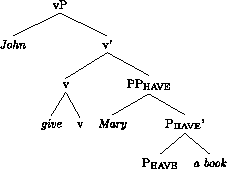
The general idea, going back to Kayne (1984), is that the two objects form a small clause. A more recent development of this hypothesis is that give and other verbs in this class (send, pass, hand, etc.) mean ‘cause to have’, where v in (12) provides the ‘cause’-element (Harley 1996, 2002; Beck and Johnson 2004; see Harley and Jung 2015 for a recent defence of this analysis against critiques in Pylkkänen 2008 and Bruening 2010a). Under this hypothesis, v assigns the Agent theta-role of the subject, while Phave assigns the theta-roles of both objects. An unusual feature of the theory underpinning this analysis is that the verb itself is merged directly with v. Harley and Jung, following Harley (2002), refer to this as “manner adjunction”; the lexical verb specifies the manner in which the recipient (R) gains possession of the theme (Th).
An alternative approach developed since the early 2000s is that the DOC involves an abstract “applicative” head, which assigns a theta role to one of the arguments, or both, depending on theoretical assumptions (McGinnis 2001; Pylkkänen 2008; Bruening 2010a). The generalizations that we will discuss, based on findings from experimental research that we will report, do not, for the most part, crucially depend on the choice between these approaches.
We assume, quite uncontroversially, that one of the objects in a DOC is assigned the case that transitive v assigns to a DP. The question then is, where the other, “extra” case comes from. We propose that one locus of cross-speaker (and cross-linguistic) variation in the distribution of Th-R vs. R-Th orders is in the way that Phave assigns case. In particular, let us assume two distinct representations in competition in the Krochian sense (Kroch 1989, 1994, 2001). One variant might be termed the “standard model” whereby phi probes agree downwards with the closest target with matching active features. In active contexts, v will agree with the recipient argument, and Phave will agree with the theme. In passive contexts, in which v does not introduce an external argument and is not a source of case, the recipient will move to TP, where it receives nominative case. We illustrate this scenario in (13), the dashed arrows here, and in subsequent trees, representing case-assignment.Footnote 3
-
(13)
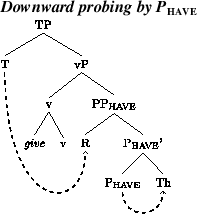
A second, competing representation, following Holmberg et al. (in press), is one where Phave agrees with and assigns case to the recipient argument in its spec. The recipient, being assigned case independently and being thereby deactivated (Chomsky 2001), does not intervene for subsequent case assignment to the theme. In active contexts, the theme will be probed by v. In passives, v, again, will not be a probe and the Theme will be probed by T and attracted to its specifier. On this approach, therefore, theme-passives are made possible by agreement between Phave and the recipient argument in its specifier, together with the assumption that the inactive recipient does not intervene for subsequent agreement operations with the Theme. We illustrate this proposal in (14). We propose that gradience in intuitions of well-formedness of these forms reflects competition between this grammar and the downward-probing option described in (13).Footnote 4 (To express the four-grammar pattern in Table 4, we will shortly posit an additional locus of variation in active contexts.)
-
(14)
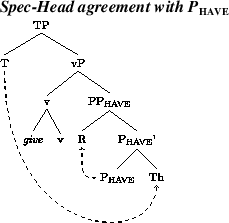
Assignment of case to the recipient by the head of the DOC is familiar from languages that have overt, dative case on the recipient, like German and Icelandic. In these languages, we take it that the dative is inherent case, assigned along with the theta role and preserved under movement (Holmberg and Platzack 1995: Ch. 7). In German, it has the consequence that the recipient cannot be passivized, as the subject of the passive can only be nominative (McFadden 2004; Georgala 2011a,b). In Icelandic, where dative DPs can be subjects, the recipient can be passivized, preserving its dative case (Holmberg and Platzack 1995: Ch. 7). The case-assignment in Norwegian (14) may be vestigial inherent case. There are dialects in Norwegian which have preserved (some) dative case, including, for some of them, on the recipient in the DOC (Eyþórsson et al. 2012). While this is a strong indication that the configuration (14) obtains in those dialects of Norwegian, we cannot draw any interesting conclusions from it for other dialects.Footnote 5 In most varieties of Norwegian, the only evidence of (14) in the primary linguistic data is the existence of theme passives. We take this to be sufficient evidence, though, for language learners to adopt (14). On the other hand, the existence of recipient passives in the primary linguistic data is evidence that the case configuration in (13) is an option as well.Footnote 6
We assume, in keeping with current phase theory, that in passive contexts, objects do not raise to TP in a single movement step but rather stop off in spec, vP, which has an EPP feature. This assumption, however, has no substantive consequences for the analysis.
Let us now consider how these assumptions help in modeling the Norwegian results above. Consider, first, the derivation of the recipient passive in (1a), repeated here.
-
(15)

Such sentences will be generated when Phave agrees downward with the theme. The recipient will subsequently raise to spec, vP, where it will be probed by T. We illustrate this in (16).
-
(16)
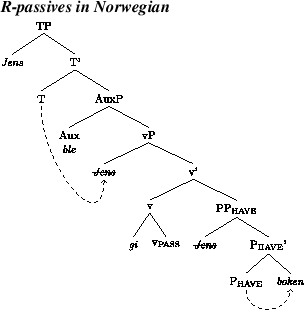
Consider, next, theme passive sentences like (15b). Such forms will be produced when Phave agrees with the recipient argument that it introduces. This allows passive v to probe the theme. Given that passive v has an EPP-feature, this will trigger movement of the theme to spec of vP, as indicated in (17). This, in turn, allows T to probe the theme, assign case to it, and trigger movement of it to spec of TP.
-
(17)
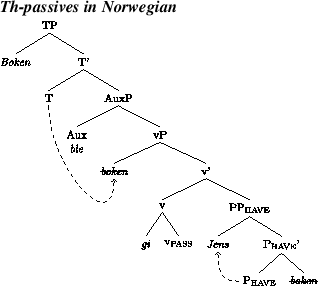
Additional assumptions will be needed to explain the word order variation in active contexts. The fact that the acceptance of Th-R orders in passive contexts does not correlate across speakers with acceptance of Th-R orders in actives suggests that the latter involves an additional locus of variation. In addition, the fact that relative acceptance of Th-R orders under object shift and vP-internally correlate positively across speakers (see Fig. 3) suggests a single locus of variation governing word order in these two contexts. We propose that the locus of variation is whether the theme can move to the edge of Phave, a property which can be formally represented as an EPP feature on Phave. More specifically, we posit two representations in competition. One will lack an EPP feature on Phave, leaving both arguments in situ and resulting in a Th-R linear order. A second representation will involve an EPP feature on Phave, which will attract the theme to its spec, as in (18), producing recipient-theme orders in active contexts. This would be a movement step that does not affect case relations, a form of scrambling. The theme would still be assigned its case by Phave, as normal in the active DOC, and the recipient would be assigned its case by v.
-
(18)
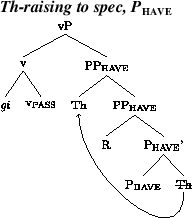
Something more, however, is needed to explain why Th-R order is preserved in object shift contexts. One possibility is that order preservation under object shift is a consequence of the fact that the object shift movement operation targets a constituent containing both objects. A principal disadvantage for such an approach is that extra-VP adverbials like sjølsagt, ‘obviously’ can intervene between the two objects in shifted contexts. This indicates that OS can move objects separately.
-
(19)
Jeg ga ham sjølsagt den ikke.
I gave him obviously it not
‘I obviously didn’t give him it.’
We pursue an alternative approach based on the observation that the object order preservation effect described above applies in exactly the same environments—object shift contexts—that a better studied shape preservation effect applies, namely Holmberg’s Generalization. Our analysis of the cross-speaker correlation in object-order preference in the two active contexts will be based on a theory of linearization originally motivated in part by Holmberg’s Generalization effects, namely Fox and Pesetsky’s (2005) Cyclic Linearization proposal. There are several formal approaches to order preservation effects (Sells 2001; Richards 2004; Fox and Pesetsky 2005; Engels and Vikner 2013). Here, we use Fox and Pesetsky’s system, which expresses the relevant facts without further assumptions.Footnote 7
Fox and Pesetsky propose that precedence relations among syntactic objects are established phase-by-phase. When a given constituent is spelled out, terminal elements are mapped to precedence relations, which are later linearized in the phonological component. Any movement operations applying to a syntactic object already spelled out must preserve the relative order of terminal elements in the previous phase, since, otherwise, spell out of the higher phase would produce a precedence relation that conflicts with one established in the lower phase. The conflicting precedence relations would then not be linearizable. Consider, for example, the case of two objects, X and Y, merged inside a phase, Phase 1. Spell out will establish the order <X,Y>. (Fox and Pesetsky call such ordered pairs, interpretable by the phonology, ordering statements.)
-
(20)
[Phase1 X, Y ] → <X,Y>
Now, consider a case where Y, but not X, moves into a higher phase, establishing the order <Y,X> at the point of spell out of the higher phase. If Y moves in one fell swoop, as in (21a), the sets of precedence relations established in the two phases will conflict—<X,Y> established by the first application of spell out and <Y,X> by the second—and the result will not be linearizable. If, however, Y moves within Phase 1 to a position preceding X the precedence relations established will be <Y,X> for both phases, and no conflict arises. Fox and Pesetsky’s approach, therefore, derives successive cyclicity from a theory of order preservation.
-
(21)

For our purposes, what will be important is a context in which multiple objects remerge in a higher phase. If extra-phasal movement permutes the relative order of the two elements, spell out of the higher phase will necessarily fix a precedence relation different from that established in the lower phase, as shown in (22a). If, on the other hand, movement preserves the relative order of these two elements as in (22b), the precedence relations established in the higher phase will match those in the lower phase, and no conflict arises.
-
(22)

Let us now apply this framework to order preservation effects under object shift. As Holmberg (1999) observes, word orders in embedded clauses suggest that the landing site of Scandinavian object shift is a position in the middle field, above vP. In (non-root) embeddings where V-to-C movement does not apply, the negative morpheme, ikke appears to the left of the perfect auxiliary, as shown in (23).
-
(23)

If we take sentences like (23) to faithfully reflect the first-merged orders of ikke and the auxiliary, then it must be the case that the first merged position of ikke is above the first merged position of auxiliaries, given the right branching structure of the lower clause in (23). We therefore take object shift to target a position above negation as in (24). For our purposes, it will not matter what exactly this landing site is, and we refer to it here as “FP.”
-
(24)
[tp T [FP Obj F …ikke … [vp V
Obj] ] ]
Given that object shift targets a position across a phase boundary from the first merged position of the objects, cyclic linearization immediately expresses the object order preservation effects under object shift. That is, permutation of the relative order of the objects under object shift is possible if and only if the objects permute in a lower phase. As mentioned, we propose that this is movement to an outer specifier of PPhave, as shown in (18). When the vP phase is spelled out/linearized, the linear order between the arguments will be Th-R. This order will be preserved under object shift, under the theory of linearization in Fox and Pesetsky (2005).
On the face of it, the movement in (18) is just the kind of short theme movement that Anagnostopoulou (2003) envisaged. However, what our results show is that there is no relation between this short movement and theme passives in Norwegian. The short theme movement is very much a minority phenomenon while theme passives are ubiquitous.
2.3 British English dialects
Somewhat similar patterns of cross-speaker variation have recently been described for British English dialects (Biggs 2014, 2015; Haddican 2010; Haddican and Holmberg 2012; Myler 2011, 2013). In this section, we consider how the framework just introduced might be extended to object order variation in these varieties.
Much previous literature has noted that some speakers of British English dialects accept theme passives in addition to recipient passives (Anagnostopoulou 2003; Doggett 2004; Woolford 1993) as in (25). Less discussed in the formal literature until fairly recently is the fact that many Northern and Western British English dialects allow for Th-R orders in active double object sentences in addition to R-Th orders as in (26). The co-occurrence of (25b) and (26b) in these dialects suggests the possibility of a single abstract source—a short theme-movement operation as in (3).Footnote 8
-
(25)

-
(26)

The predictions of the locality approach for these facts are similar to those outlined above for Norwegian: speakers should accept Th-R orders in passives if and only if they also accept Th-R orders in the active context in (26b). (Haddican and Holmberg note that the objects in (26) are unlikely to have undergone object shift—at least not as high as that in Norwegian—and so these sentences are comparable to the active non-object shift sentences in Table 2.) To test this prediction, Haddican and Holmberg carried out a judgment experiment with 137 native speakers of Northern and Western British English dialects. Their results revealed a positive correlation across speakers in acceptance of (25b) and (26b) as indeed expected from the perspective of the locality approach. Nevertheless, Haddican and Holmberg noted two main facts about these dialects that are problematic from the perspective of the locality hypothesis. A first concerns cross-speaker variation in the data. Some speakers in the sample accepted Th-R orders in both passive and active contexts, and others accepted neither, which is expected on the locality approach. In addition, however, many speakers in these dialect areas accept Th-R orders in active contexts but not in passive contexts. This is not predicted by the locality approach, since the availability of movement to the “escape hatch” position should necessarily make available theme passivization. No speakers in Haddican and Holmberg’s sample showed the fourth possible pattern: acceptance of theme-passives but not Th-R orders in actives. These patterns of responses correspond to Grammars 1, 2 and 4 in Table 4 for Norwegian. The British English counterpart of Norwegian Grammar 3 is unattested in Haddican and Holmberg’s sample.
A second obstacle for a locality approach to (25) and (26) has to do with a restriction on themes in active but not passive contexts. The theme in Th-R active sentences in the relevant dialects must be a weak pronoun. Compare (26b) and (27).
-
(27)
*She gave the book him/John.
No such restriction on themes applies in passives; that is, both pronominal and full DP themes are possible, as in (25b). From the perspective of the locality approach illustrated in (3), these facts seem to require that full DPs can move through the escape hatch position, but only if they move on subsequently to subject position (or a phase edge).
The speakers that accept the Th-R order in the active or the passive have a grammar in which R is assigned the “extra case” of the DOC allowing Th to be assigned the “regular” objective case by v. Haddican and Holmberg (2012) propose, in part following Baker and Collins (2006), that these grammars have an additional head, a Linker, which assigns case to R. For the sake of exposition, we will reformulate Haddican and Holmberg’s analysis in present terms; this will not affect the principal claims made in that paper. The structure of the DOC is (12), repeated here.
-
(28)
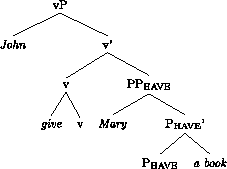
In the grammars responsible for the Th-R order, Phave assigns case to R, deactivating it, which allows v to probe Th across R. Following Chomsky (2001), the Agree relation between v and Th entails that v’s unvalued set of phi-features are valued by copying the phi-feature values of the object, while the object is assigned objective case. In the case where Th is a weak pronoun, taken to be a pronoun with no D but phi-features only (following Cardinaletti and Starke 1999), the features of the pronoun will thereby be a subset of the features of v. Following Roberts (2010), this means that v and the pronoun form a chain of two copies. By the ordinary chain reduction rule at PF (Nunes 2004), the higher copy will be spelled out, the lower copy will not. Roberts (2010) refers to this as “incorporation” of the goal into the probe. Now, the English pronoun it is a weak pronoun. Following incorporation, the order in an active DOC with it as Th will be as in (26b), with it spelled out preceding R. In contexts with full DP themes, no such incorporation will apply and the theme will spell out in its lower position. The structure in (28), together with Roberts’ (2010) incorporation proposal therefore gives the desired result that, in this grammar, inversion is only possible with weak themes.
In passive contexts, where no external argument is merged, Haddican and Holmberg assume, as is standard, that passive v is not a case assigner. In the structure in (28), now taken to be a passive and therefore without an external argument, Phave will assign case to R. In a subset of these grammars, passive v has an EPP feature, triggering movement of Th to the edge of vP, where it can then be probed by T, be assigned nominative case, and move on to spec,TP (active transitive v always has an EPP feature checked by the external argument). The grammar with Th-R order in active but not passive contexts differs minimally from the above in that v lacks an EPP feature triggering movement of Th to the spec of vP. Given that a direct Agree relation between T and the theme in vP is impossible, because either passive vP or Phave/Appl is a phase (in the sense of Chomsky 2000, 2008), the theme is thereby trapped case-less in situ.
Haddican and Holmberg’s (2012) results from Northwest British English dialects provide additional support for the role of case vis-à-vis locality in modeling passive symmetry. Their analysis, moreover, is close in spirit to the proposals for Norwegian presented above. What crucially distinguishes NW British English from Norwegian is the fact that the latter has an additional operation, Object Shift, absent in the former. (See Haddican and Holmberg 2012 and Holmberg 1999 for discussion.) We turn to a final set of data supporting a case-based approach to passive symmetry in the next section.
3 Verb class effects in Swedish
In the remaining discussion, we focus on passivization out of double object constructions in Swedish. As in English and Norwegian, the base order of double object constructions is R-Th (Holmberg and Platzack 1995: 190–194). Double object constructions in the order Th-R orders with two full DPs are sharply degraded as shown in (29b).
-
(29)

As in Norwegian and English, recipient arguments in Swedish DOCs must not be inanimate as in (30).
-
(30)

We therefore take Swedish sentences of the kind in (29a) to be bona fide DOCs, as standardly assumed (Holmberg and Platzack 1995: 190–199). We assume, therefore, that the structure of the Swedish DOC is like the English structure (12), (repeated here), as assumed previously in the analysis of Norwegian.
-
(31)
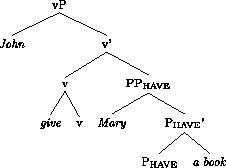
In the A-movement literature, Swedish is sometimes described as a symmetric passive language (Woolford 1993; Anagnostopoulou 2003; Platzack 2005). As we will show, this is indeed the case, but not in the way it is usually portrayed. First, as noted by Holmberg and Platzack (1995), with many garden variety ditransitive verbs including ge, ‘give’, theme passives are quite poor.
-
(32)

This effect was described by Lundquist (2004) based on corpus results. However, his investigation did not show any significant difference between R-passives and Th-passives of the verb ge ‘give’; both were about equally rare. This was further confirmed in a dialect survey reported in Lundquist (2014): out of 192 speakers in 48 locations distributed all over Sweden and the Swedish-speaking parts of Finland (4 speakers per location) close to 92% rejected the sentence (we represent this as ??).Footnote 9
-
(33)

However, Holmberg and Platzack (1995:219–220) report that theme passives are better with a class of bimorphemic verbs, including tilldela, ‘award’, tillskriva ‘ascribe’, and förära ‘award’, as in (34):
-
(34)

The first morphemes in some of these verbs are homophonous with prepositions, including till ‘to’, an observation which was taken to be significant by Holmberg and Platzack (1995). The generalization was confirmed by Lundquist’s (2004) investigation. But, again, his investigation showed the same effect for R-passives, which also improve with this class of verbs.
-
(35)
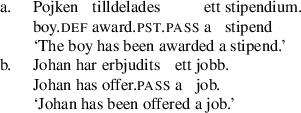
From the perspective of the approach to passive symmetry proposed in the previous section, one possible understanding of the contrast observed by Holmberg and Platzack (1995) and Lundquist (2004, 2014) between (32) and (33) on the one hand, and (34) and (35) on the other hand, is (a) the passive formed with a simple ditransitive verb such as ge ‘give’ fails to assign case to one of the objects which remains in vP, and (b) the preposition-like prefixes provide the extra source of case otherwise absent.
A possibility which should be controlled for is that the bimorphemic verbs in (34) and (35) are derived from the V+PP construction rather than the DOC. This can be tested with the verb tillsända ‘send’.
-
(36)
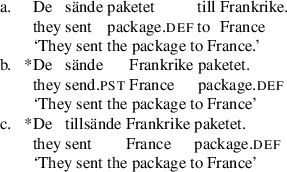
The bimorphemic alternative here patterns with the DOC, not with the V+PP construction, as it needs an animate receiver, which follows if the constructions in (34) and (35) are passives of the DOC under the ‘cause to have’ hypothesis that we have adopted here.
Many Swedish speakers, including linguists that we have consulted, find the contrasts in (32)–(35) quite subtle, and judgments vary from speaker to speaker. To understand these facts better and to examine possible between-subjects effects, we carried out a controlled judgment experiment. Subjects in the experiment were 101 self-described native speakers of Swedish aged 22 to 87 (M = 38.4, SD = 12.0); 66 were women. Subjects were recruited online by the researchers. We did not require subjects to be linguistically naïve. Subjects were not compensated for their participation.
The experiment crossed two factors: object order, with levels R-Th Th-R, and verb class, with two levels: monomorphemic and bimorphemic. All theme and recipient arguments were third person pronouns. Theme vs. recipient interpretation of arguments was biased using animate pronouns for recipients and inanimate pronouns for themes. We summarize these four conditions in Table 5.
The procedure for the experiment was similar to that of the Norwegian experiment described above. Twelve lexicalizations were created for each of these four conditions. These were blocked and assigned to one of twelve lists by Latin square. Each subject saw four items per condition. These 16 sentences were pseudorandomized with 24 filler sentences: half grammatical, half ungrammatical. Subjects judged each of these sentences on an 11-point scale with endpoints labeled dålig (‘bad’) and bra (‘good’). Subjects were assigned to lists by the software using a counter. A list of the experimental items appears in Appendix 2.Footnote 10
A possible confound in the experiment concerns stylistic effects. If theme passives are associated with more formal speech events, then any verb class-effect could conceivably be attributable to a register effect rather than a grammatical one. To address this possibility, the acceptability judgment task described above was followed by a formality judgment task. Participants were asked to judge the formality of theme-passive vs. recipient-passive sentences taken from the monomorphemic condition. Subjects judged four sentences from both of these two conditions along with eight fillers on an eleven-point (0–10) scale, with endpoints labeled informella (‘informal’) and formella (‘formal’), respectively.
Table 6 summarizes the fixed effects from a linear regression model with random intercepts for subject and lexicalization and a by-subject random slope for order. The reference levels for the morphological factor was Bimorphemic and for the order factor Recipient-Theme.Footnote 11
The analysis revealed a significant interaction between verb class and object order, as illustrated in Fig. 4, which shows mean scores and 95% confidence intervals for the four conditions. Figure 4 shows that both passive types are rated fairly low with monomorphemic verbs, as originally noted by Lundquist (2004). Both passive types improve in the bimorphemic condition. In addition, Fig. 4 illustrates an interaction between verb class and word order: theme passives are judged roughly on a par with recipient-passives with bimorphemic verbs, but much lower in the monomorphemic condition. The fact that theme-passives improve relative to recipient-passives with bimorphemic class verbs is in line with Holmberg and Platzack’s (1995: 219–220) observation. We return to this effect shortly.Footnote 12
An analysis of the results from the second subdesign focusing on a possible stylistic difference between theme-passives and recipient-passives revealed no effect. To test further for possible stylistic effects, by-subject random slopes from a model of the subdesign 2 results were included as covariates in the modeling of the verb class*order interaction. This factor did not contribute significantly to the model.Footnote 13
We take the fact that both R-passives and Th-passives are degraded with monomorphemic verbs to suggest that v is involved in the licensing of both arguments in active contexts. Given standard assumptions about case and the passive this conclusion is almost inescapable. We propose that Swedish differs from Norwegian in that, in active contexts, there is “multiple agreement”—that is, a single probe that values case on both theme and goal arguments (Anagnostopoulou 2003; Nevins 2007, 2011). We take this probe to be v, as illustrated in (37). In passive contexts, we propose that this head fails to assign case, as in Norwegian, with the consequence that, in passive contexts, one of the two internal arguments will necessarily be left case-less in violation of the case filter. These assumptions together, therefore, express the fact that passivization of both arguments out of Swedish DOCs is degraded. In addition, to the extent that passives are available with this class of verbs they are accepted with R passives. We take this to mean that the grammar where Phave is a source of case is marginally available. The fact that Th-passives are sharply degraded with monomorphemic verbs suggests that, unlike in Norwegian, the grammar where Phave agrees with its specifier is unavailable in Swedish.
-
(37)

We propose that, in the case of Swedish bimorphemic verbs, the prefixal P provides an extra source of case. Specifically, let us assume that Swedish bimorphemic verbs of the kind described above are complex heads with the structure in (38).
-
(38)
[v [v P V ] v ]
Let us further assume that P’s properties as a probe—that is, its uninterpretable ϕ features—transfer to v, but only in the case of passive v, where v itself lacks uninterpretable ϕ features. Enriched with the ϕ features of P, v probes and agrees with the recipient—the closest active goal—with the consequence that the theme will be case-less until subsequently probed by T. We illustrate this variation in (39). The assumption of an additional source of case outside of the projection containing the two objects, together with the assumption that inactive recipients need not defectively intervene, immediately expresses the fact that bimorphemic verbs selectively ameliorate theme passives.Footnote 14 In addition, Fig. 4 shows that R-passives also improve to some degree with bimorphemic verbs, though to a lesser extent than Th-passives. Following the logic of our argument so far, we suggest that the grammar just proposed may compete with a minority variant where the uϕ-features transmitted from P to v are transmitted once more to Phave, and thus probe the theme, leaving the recipient to be probed by T.
-
(39)
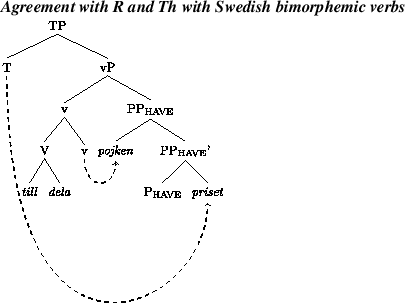
Under this theory, passive symmetry in Norwegian and Swedish have different sources, both related to mechanisms of case assignment. In Norwegian, Th-passives are made possible by a grammar in which Phave may assign case to the recipient in its specifier, enabling promotion of the theme. In Swedish, the fact that both R-passives and Th-passives are degraded with monomorphemic, give-class verbs, suggests that Phave can only marginally be a case-assigner in Swedish, which is “symmetric” with this class of verbs only in the sense that neither passive is good. What improves Th-passives in Swedish is the presence of an additional source of case above PPhave, namely the prepositional prefix.Footnote 15
A final point to consider is whether there is any explanation for why Swedish should differ from cognate languages like Norwegian, Danish, and English in the way it disallows or disprefers passives of simple ditransitive verbs. Another striking difference between Swedish and the other languages is that Swedish has a synthetic passive as the unmarked passive form where the other languages have a periphrastic passive as the unmarked form (Lundquist 2009; Laanemets 2013). The synthetic passive is formed with an affix –s on the verb (generally regarded as historically derived from the 3rd person reflexive pronoun). Could there be a connection between having the s-passive as the unmarked form and disallowing passives of the DOC? We can test this, because Norwegian (as well as Danish) also employs the s-passive, although only in the present tense and in construction with a modal verb. The question, then, is how Norwegian s-passives, as in (40) compare with the periphrastic passives, as in (41).
-
(40)

-
(41)

According to our Norwegian informants there is no difference between (41) and (40); they are equally acceptable. We see no reason, therefore, to think that the choice between the periphrastic and the synthetic passive makes any difference in the DOC.Footnote 16
4 Conclusion
This paper has described two large-sample judgment experiments with speakers of Swedish and Norwegian that have three main outcomes relevant to current formal approaches to the passive symmetry problem. First, the Norwegian results fail to support a prediction of Anagnostopoulou’s (2003) seminal locality-based approach to passive symmetry in Norwegian, namely that speakers should accept theme-passives if and only if they accept Th-R orders in object shift. Second, results from a survey of Swedish speakers support observations by Holmberg and Platzack (1995) and Lundquist (2004, 2014) of a verb class effect on passivization out of double object constructions: both theme- and recipient passives are degraded with give-class verbs, and both ameliorated with a set of verbs with preposition-like prefixes. This effect is not predicted by the locality approach. Third and finally, the Norwegian results suggest a shape conservation effect in object shift contexts not previously reported in the literature. Th-R orders in Norwegian object shift contexts are available for just those speakers who also accept Th-R orders in active non-object shift contexts. This object ordering constraint applies in the same environment that another, much better described ordering constraint applies, namely Holmberg’s Generalization. We have shown that these results are explained by Fox and Pesetsky’s (2005) cyclic linearization proposal together with the assumption that Th-R orders vP-internally reflect short theme-movement within the vP phase.
We have assumed the theory of the DOC advocated by Harley (2002, 2008) and Harley and Jung (2015) whereby the DOC means ‘cause to have’ and the two objects form a small clause headed by a head Phave. There is variation among languages with a DOC regarding how case is assigned to the objects. In one type, the recipient is assigned the regular object case by v, in the active voice, and nominative by T in the passive, while the theme is assigned ‘extraordinary case’ by Phave. The result is that R-passives are well formed, but Th-passives cannot be derived. Standard English and Danish would be representatives of this type. In another type, the recipient is assigned extraordinary case by Phave in a spec-head configuration. The theme can then be assigned the regular object case by v. This would be the case in languages with a DOC where Th-passives are well formed but R-passives are not. German would be a representative of this type. In a third type of language, represented by Norwegian, both grammatical options are available, and as a result R-passives and Th-passives are both well-formed. In yet another type of language, represented by Swedish, the objects are both assigned case by v in the active voice, with the result that neither passive is well-formed, since one of the objects will always be left without a case. Swedish has a class of verbs, though, with a prepositional prefix, which can provide the extraordinary case needed to derive Th-passives and R-passives.
Notes
The t-tests use degrees of freedom approximated using the Satterthwaite method in the lmerTest package (Kuznetsova et al. 2016).
No regional or sex effects emerged as significant in the modeling. The results revealed an age effect with younger speakers favoring R-Th orders in passives and older speakers favoring Th-R orders. See Haddican et al. (2016) for a discussion of these results, which are not directly relevant to the issues considered here.
This would correspond to what is called “secundative alignment” in the typological literature, as opposed to “indirective alignment” described in the text below (Malchukov et al. 2010). In our model overt case-marking is not a defining characteristic of the two alignment types, though.
On the basis of fieldwork with speakers from areas in Norway where dative case is particularly prevalent, Eyþórsson et al. (2012) show that none of them accept preservation of dative under passivization of the recipient of the DOC. This does not tell us whether the case is inherent or not since there are other, independent reasons why dative subjects are not allowed by the grammar of today’s Norwegian; see Holmberg and Platzack (1995: 112–115); Holmberg (2010).
A reviewer for NLLT suggests that speakers of Norwegian dialects with dative case would be expected to just have a grammar with (14), rather than the competition between grammars with (13) and (14), respectively, that most Norwegians have. Given the weak status of dative case in the dialects in question, demonstrated by Eyþórsson et al. (2012), this is somewhat unlikely. There may well be no speakers left that use dative consistently, in the relevant contexts. Our analysis revealed no preference for theme-passives among speakers who reported a hometown within the traditional dative-preserving dialect area.
We note that Richards’ (2004) approach to order preservation will not yield the correct facts for Norwegian, since on this approach, precedence is determined by sisterhood relations. Since Th and R are not plausibly in a sisterhood relation (nor mediated by a phonologically overt head) the proposal won’t ensure R, Th order preservation.
There is some variation across dialects in the representation of strings like (25b). In some dialects they behave like double object constructions on standard diagnostics, while in others, they behave like prepositional datives with a silent preposition. See Biggs (2014, 2015); Haddican (2010) and Myler (2011, 2013) for discussion. Haddican and Holmberg (2012) focus on the dialects relevant for our purposes—those where such forms behave like true DOCs.
Thanks to Björn Lundquist for a discussion of these data. A reviewer for NLLT suggests that the bad recipient passives with ge ‘give’ may be because of morphological blocking by the verb få ‘get, receive’. That is, (i) would block (ii).
-
(i)

-
(ii)

However, as Norwegian has the verb få with exactly the same meaning and use as Swedish (main verb) få, how come there is no blocking in Norwegian? (Swedish also has a modal auxiliary få ‘may’, absent in Norwegian, but this is irrelevant.)
-
(iii)

-
(iv)

Furthermore, why are R-passives with other Swedish ditransitives such as visa ‘show’ and skicka ‘send’ not good, either (as our investigation, reported below, confirmed)? These verbs should not be blocked by få ‘get’.
-
(v)

-
(i)
The experiment included an additional subdesign focusing on clause type effects on object order. Each list contained an additional eight sentences from this condition. We do not discuss these results here.
As in the Norwegian modeling, the t-tests are based on degrees of freedom approximated using the Satterthwaite method in the lmerTest package (Kuznetsova et al. 2016).
A reviewer notes that the monomorphemic verbs generally have an alternative realization, namely the prepositional dative construction (V-DP-PP), which the bimorphemic verbs often do not have. As implied by the reviewer, this may be part of the explanation for their different status in passives. We will have to leave this suggestion for future research. A factor to take into account, in that case, is that some of the bimorphemic verbs do allow a prepositional dative alternative. For instance tillskriva ‘ascribe’ does not, but förevisa ‘show’ does.
-
(i)

-
(ii)

-
(i)
Modeling revealed no effect for subject sex, age or region for either subdesign.
A referee for NLLT suggests that the relevant bimorphemic verbs may be derived by preposition incorporation in the syntax. This is an attractive idea as it would, presumably, simplify case assignment, but there are two related reasons to reject it. First, only some of the bimorphemic verbs have a counterpart with a bare verb and a PP. Tillsända ‘send’ and (arguably) förevisa ‘show’ do, but for example tilldela ‘award’ and anförtro ‘entrust’ do not. Second, with the possible exception of (again) tillsända and förevisa, the meaning of the bimorphemic verbs is not compositionally derived from the meaning of the corresponding bare verb and the preposition. If compositional meaning is a criterion, then the bimorphemic verbs are not derived by incorporation.
A reviewer for NLLT points out that some of the verbs with prepositional prefixes can take their two objects in either order, in active predicates. If this is true across the board, this would explain why they, of all Swedish verbs, accept both R-passives and Th-passives, and furthermore, it would explain it purely on the basis of locality. The interesting observation holds true perhaps most clearly for the verb tillskriva ‘ascribe’.
-
(i)

Here the R-passive could be derived from the underlying structure of (ia), and the Th-passive from the underlying structure of (ib). This duality does not seem to hold for the other verbs in our investigation, though, not even the ones that are most amenable to R- and Th-passives. Tilldela ‘award’ and förevisa ‘show’ are two of them.
-
(ii)
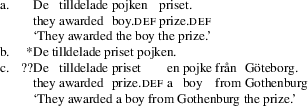
-
(iii)

For tilldela the definiteness of the objects seems to have a marginal effect, but not for förevisa.
-
(i)
If the choice between the synthetic and the periphrastic passive makes no difference in the DOC, Danish should allow R-passives but not Th-passives, where Norwegian accepts both. While this requires more careful research, preliminary results indicate that this is right (thanks to Sten Vikner for discussion of this point). Compare the s-passives in Norwegian (i) with the ones in Danish (ii).
-
(i)

-
(ii)

-
(i)
References
Anagnostopoulou, Elena. 2003. The syntax of ditransitives: Evidence from clitics. Berlin: de Gruyter.
Anagnostopoulou, Elena. 2005. Holmberg’s generalization and cyclic linearization: Remarks on Fox and Pesetsky. Theoretical Linguistics 31 (1–2): 95–110.
Baker, Mark, and Chris Collins. 2006. Linkers and the internal structure of vP. Natural Language and Linguistic Theory 24: 307–354.
Baker, Mark C. 1988. Incorporation: A theory of grammatical function changing. Chicago: University of Chicago Press.
Bates, Douglas, Martin Mächler, Ben Bolker, and Steve Walker. 2015. Fitting linear mixed-effects models using lme4. Journal of Statistical Software 67 (1): 1–48. doi:https://doi.org/10.18637/jss.v067.i01.
Beck, Sigrid, and Kyle Johnson. 2004. Double objects again. Linguistic Inquiry 35 (1): 97–123.
Biggs, Alison. 2014. Passive variation in the dialects of Northwest British English. Ms., Cambridge University.
Biggs, Alison. 2015. A new case for A-movement in Northwest British English. In West Coast Conference on Formal Linguistics (WCCFL) 32, eds. Ulrike Steindl, Thomas Borer, Huilin Fang, Alfredo García Pardo, Peter Guekguezian, Brian Hsu, Charlie O’Hara, and Iris Chuoying Ouyang, 218–227. Somerville: Cascadilla Proceedings Project.
Bobaljik, Jonathan David. 2002. A-chains at the PF-interface: Copies and covert movement. Natural Language and Linguistic Theory 20 (2): 197–267.
Bobaljik, Jonathan David. 2005. Re: CycLin and the role of PF in Object Shift. Theoretical Linguistics 31 (1–2): 111–125.
Bresnan, Joan, and Lioba Moshi. 1990. Object asymmetries in comparative Bantu syntax. Linguistic Inquiry 21 (2): 147–185.
Bruening, Benjamin. 2010a. Ditransitive asymmetries and a theory of idiom formation. Linguistic Inquiry 41 (4): 519–562.
Bruening, Benjamin. 2010b. Double object constructions disguised as prepositional datives. Linguistic Inquiry 41 (2): 287–305.
Chomsky, Noam. 2000. Minimalist inquiries: The framework. In Step by step: Essays on minimalist syntax in honor of Howard Lasnik, eds. Dan Michaels, Roger Martin, and Juan Uriagereka, 83–155. Cambridge: MIT Press.
Chomsky, Noam. 2001. Derivation by phase. In Ken Hale: A life in language, ed. Michael Kenstowicz, 1–52. Cambridge: MIT Press.
Chomsky, Noam. 2008. On phases. In Foundational issues in linguistic theory: Essays in honor of Jean-Roger Vergnaud, eds. Robert Freiden, Carlos P. Otero, and Maria Luisa Zubizarreta, Vol. 45, 133–166. Cambridge: MIT Press.
Doggett, Teal Bissell. 2004. All things being unequal: Locality in movement. PhD diss., Massachusetts Institute of Technology.
Drummond, Alex. 2013. Ibex Farm. Experiment hosting. Available at http://spellout.net/ibexfarm. Accessed 6 October 2017.
Engels, Eva, and Sten Vikner. 2013. Object shift and remnant VP-topicalisation: Danish and Swedish verb particles and let-causatives. Nordic Journal of Linguistics 36 (02): 219–244.
Eyþórsson, Þórhallur, Janne Bondi Johannessen, Signe Laake, and Tor A. Åfarli. 2012. Dative case in Norwegian, Icelandic and Faroese: Preservation and non-preservation. Nordic Journal of Linguistics 35 (3): 219–249.
Fox, Danny, and David Pesetsky. 2005. Cyclic linearization of syntactic structure. Theoretical Linguistics 31 (1–2): 1–45.
Georgala, Effi. 2011a. Applicatives in their structural and thematic function: A minimalist account of multitransitivity. PhD diss., Cornell.
Georgala, Effi. 2011b. Why German is not an exception to the universal <IO, DO> base order of double object constructions. In West Coast Conference on Formal Linguistics (WCCFL) 28, ed. Mary Byram Washburn, 96–105. Somerville: Cascadilla Proceedings Project.
Green, Georgia M. 1974. Semantics and syntactic regularity. Bloomington: Indiana University Press.
Haddican, Bill, and Anders Holmberg. 2012. Object movement symmetries in British English dialects: Experimental evidence for a mixed case/locality approach. Journal of Comparative Germanic Linguistics 15 (3): 1–24.
Haddican, Bill, Daniel Ezra Johnson, and Nanna Haug Hilton. 2016. Constant effects and the independence of variants in controlled judgment data. Linguistic Variation Yearbook 16 (2): 247–266.
Haddican, William. 2010. Theme–goal ditransitives and theme passivisation in British English dialects. Lingua 120 (10): 2424–2443.
Harley, Heidi. 1996. If you have, you can give. In West Coast Conference on Formal Linguistics (WCCFL) 15, eds. Brian Agbayani and Sze-Wing Tang, 193–207. Stanford: CSLI.
Harley, Heidi. 2002. Possession and the double object construction. Linguistic Variation Yearbook 2 (1): 31–70.
Harley, Heidi, and Hyun Kyoung Jung. 2015. In support of the Phave analysis of the double object construction. Linguistic Inquiry 46: 703–730.
Holmberg, Anders. 1986. Word order and syntactic features in the Scandinavian languages and English. PhD diss., Stockholm University.
Holmberg, Anders. 1999. Remarks on Holmberg’s generalization. Studia Linguistica 53 (1): 1–39.
Holmberg, Anders, and Christer Platzack. 1995. The role of inflection in Scandinavian syntax. Oxford: Oxford University Press.
Holmberg, Anders, Michelle Sheehan, and Jenneke van der Wal. In press. Movement from the double object construction is not fully symmetrical. To appear in Linguistic Inquiry
Jaeggli, Osvaldo A. 1986. Passive. Linguistic Inquiry 17 (4): 587–622.
Jeong, Youngmi. 2007. Applicatives: Structure and interpretation from a Minimalist perspective. Amsterdam: Benjamins.
Kayne, Richard S. 1984. Connectedness and binary branching. Dordrecht: Foris.
Kroch, Anthony. 1989. Reflexes of grammar in patterns of language change. Language Variation and Change 1 (3): 199–244.
Kroch, Anthony. 1994. Morphosyntactic variation. In Regional meeting of the Chicago Linguistics Society (CLS) 30, ed. Katharine Beals, 180–201. Chicago: Chicago Linguistic Society.
Kroch, Anthony. 2001. Syntactic change. In The handbook of contemporary syntactic theory, eds. Mark Baltin and Chris Collins, 699–729. Oxford: Blackwell.
Kuznetsova, Alexandra, Per Bruun Brockhoff, and Rune Haubo Bojesen Christensen. 2016. lmertest: Tests in linear mixed effects models. R package version 2.0–30. Available at http://CRAN.R-project.org/package=lmerTest. Accessed 6 October 2017.
Laanemets, Anu. 2013. The passive voice in spoken and written Danish, Norwegian and Swedish: A comparative corpus-based study. Languages in Contrast 13 (1): 67–89.
Lundquist, Björn. 2004. Subjektsval vid passivering av ditransitiva verb. Master’s thesis, University of Lund.
Lundquist, Björn. 2009. Nominalizations and participles in Swedish. PhD diss., University of Tromsø.
Lundquist, Björn. 2014. Double object constructions: Passive verbs. Nordic Atlas of Language Structure 1: 146–148.
Malchukov, Andrej, Martin Haspelmath, and Bernard Comrie. 2010. Ditransitive constructions: A typological overview. In Studies in ditransitive constructions: A comparative handbook, eds. Andrej Malchukov, Martin Haspelmath, and Bernard Comrie, 1–64. Berlin: De Gruyter.
McFadden, Thomas. 2004. The position of morphological case in the derivation. PhD diss., University of Pennsylvania.
McGinnis, Martha. 1998. Locality in A-movement. PhD diss., MIT.
McGinnis, Martha. 2001. Phases and the syntax of applicatives. In North East Linguistic Society (NELS) 31, 333–350. Amherst: GLSA.
Myler, Neil. 2011. Come the pub with me: Silent TO in a dialect of British English. NYU Working Papers in Linguistics (NYUWPL) 3: 120–135.
Myler, Neil. 2013. On coming the pub in the North West of England: Accusative unaccusatives, dependent case, and preposition incorporation. The Journal of Comparative Germanic Linguistics 16 (2-3): 189–207.
Nevins, Andrew. 2007. The representation of third person and its consequences for person-case effects. Natural Language and Linguistic Theory 25 (2): 273–313.
Nevins, Andrew. 2011. Multiple agree with clitics: Person complementarity vs. omnivorous number. Natural Language and Linguistic Theory 29 (4): 939–971.
Nunes, Jairo. 2004. Linearization of chains and sideward movement. Cambridge: MIT Press.
Platzack, Christer. 2005. Cross-Germanic promotion to subject in ditransitive passives: A feature-driven account. In Grammar and beyond. Essays in honour of Lars Hellan, eds. Mila Vulchanova and Tor A. Åfarli, 135–166. Oslo: Novus Press.
Postal, Paul Martin. 2004. Skeptical linguistic essays. Oxford: Oxford University Press.
Pylkkänen, Liina. 2008. Introducing arguments. Cambridge: MIT press.
R Core Team. 2014. R: A language and environment for statistical computing. Vienna: R Foundation for Statistical Computing. Available at http://www.R-project.org/. Accessed 6 October 2017
Richards, Marc. 2004. Object shift and scrambling in North and West Germanic: A case study in symmetrical syntax. PhD diss., University of Cambridge.
Richards, Norvin. 1997. What moves where when in which language? PhD diss., MIT.
Roberts, Ian. 1987. The representation of implicit and dethematized subjects. Dordrecht: Foris.
Roberts, Ian. 2010. Agreement and head movement: Clitics, incorporation and defective goals. Cambridge: MIT Press.
Sells, Peter. 2001. Structure, alignment and optimality in Swedish. Stanford: CSLI.
Ura, Hiroyuki. 1996. Multiple feature-checking: A theory of grammatical function splitting. PhD diss., Massachusetts Institute of Technology.
Woolford, Ellen. 1993. Symmetric and asymmetric passives. Natural Language and Linguistic Theory 11 (4): 679–728.
Acknowledgements
Many many thanks to Caroline Heycock and to three very insightful NLLT reviewers for careful critical discussions. Thanks also to our participants and to Elena Anagnostopoulou, Kali Bybel, Karthik Durvasula, Liliane Haegeman, Nanna Haug Hilton, Dan Johnson, Adam Liter, Alan Munn, Cristina Schmitt, Marit Westergaard and audiences at Penn, Michigan State, PLC39, BLS40, CGSW35 and GLOW37. Anders Holmberg’s research was funded by the European Research Council Advanced Grant No. 269752 ‘Rethinking Comparative Syntax’ (ReCoS). Thanks to the ReCoS team for their support, and especially to Jenneke van der Wal and Michelle Sheehan. All errors are our own.
Author information
Authors and Affiliations
Corresponding author
Rights and permissions
Open Access This article is distributed under the terms of the Creative Commons Attribution 4.0 International License (http://creativecommons.org/licenses/by/4.0/), which permits unrestricted use, distribution, and reproduction in any medium, provided you give appropriate credit to the original author(s) and the source, provide a link to the Creative Commons license, and indicate if changes were made.
About this article
Cite this article
Haddican, B., Holmberg, A. Object symmetry effects in Germanic. Nat Lang Linguist Theory 37, 91–122 (2019). https://doi.org/10.1007/s11049-018-9404-5
Received:
Accepted:
Published:
Issue Date:
DOI: https://doi.org/10.1007/s11049-018-9404-5























































